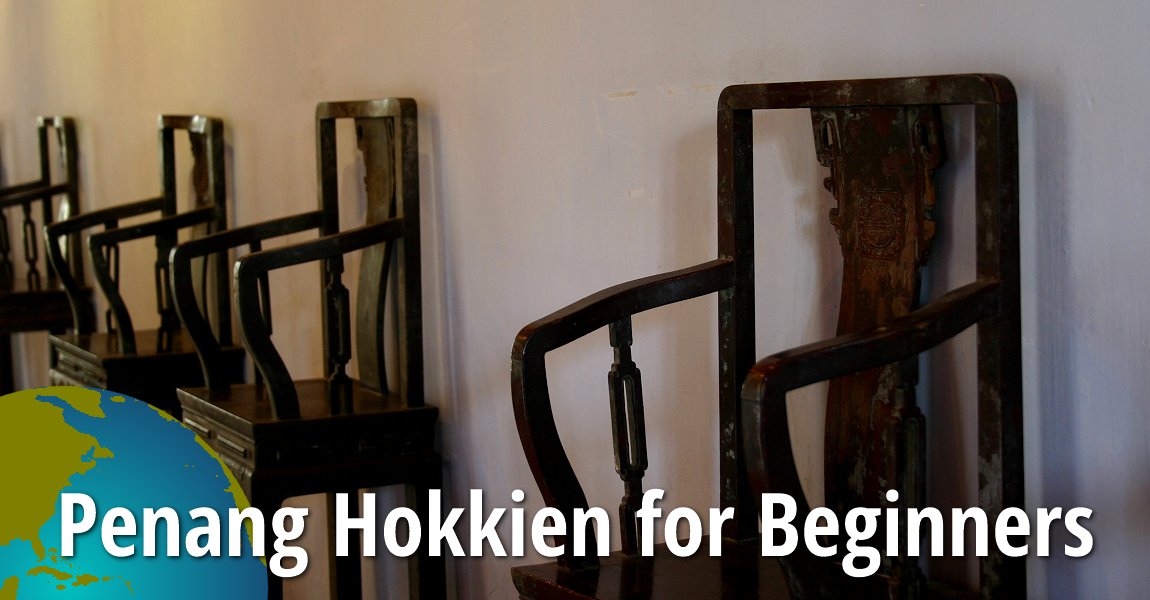 Penang Free School, where Sham studies (21 October, 2016)
Penang Free School, where Sham studies (21 October, 2016)
In this lesson, we meet Hishamuddin, who is also known as Sham among his friends. He is 17 years old and goes to Penang Free School, one of the major secondary schools in Penang. In Sham's class are many Chinese students. At school they speak English, but after school they switch to Penang Hokkien. Sham wants to be able to understand his classmates when they speak Penang Hokkien, so he asked his best friend Jimmy to teach him Penang Hokkien. As Sham embarks on his journey to learn Penang Hokkien, we learn along.
The following article is written in Penang Hokkien using Taiji Romanisation. Each sentence is following by an audio track. Point your cursor to the audio icon to see the translation, and click on the icon to hear the sentence read in Penang Hokkien. The article is followed by the vocabulary list, showing you the words used in the sentence, with explanation where necessary.
Reading 1
Now the protagonist of our lessons will tell us about himself.Wah1 mia3 Hishammuddin.
 Lu1 e33 kio33 wah4 co1 Sham4.
Lu1 e33 kio33 wah4 co1 Sham4.  Wah1 thark3 teong3ok1.
Wah1 thark3 teong3ok1.  Wah1-eh3 ok3tng2 mia3 Penang Free School.
Wah1-eh3 ok3tng2 mia3 Penang Free School. 
Ti1 wah1-eh3 pan1 uh33 cin3 ce33 Tng3lang3 knia4.
 Ti1 pan1 ie1lang2 kong1 Ang3mor3 wa33.
Ti1 pan1 ie1lang2 kong1 Ang3mor3 wa33.  Pang1 ok1 liau4, ie1lang2 kong1 Hok1kien1 wa33.
Pang1 ok1 liau4, ie1lang2 kong1 Hok1kien1 wa33.  Wah1 be33hiau4 Hok1kien1 wa33.
Wah1 be33hiau4 Hok1kien1 wa33.  Wah1 be33hiau1 thnia1 ie1lang2 kong4 ha1mik1.
Wah1 be33hiau1 thnia1 ie1lang2 kong4 ha1mik1. 
Wah1 uh33 cit3-khien1 ho1 peng3iu4.
 Ie1 mia3 Jimmy.
Ie1 mia3 Jimmy.  Jimmy si33 Tng3lang3 knia4 lai2.
Jimmy si33 Tng3lang3 knia4 lai2.  Ie1 siang33 pan1 ka1 wah4.
Ie1 siang33 pan1 ka1 wah4.  Ie1 e33hiau1 kong4 Hok1kien1 wa33.
Ie1 e33hiau1 kong4 Hok1kien1 wa33. 
Wah1 kio33 Jimmy ka3 wah4 Hok1kien1 wa33.
 Thau3-thau2 ie1 kong4 ie1 be33hiau1 ka3.
Thau3-thau2 ie1 kong4 ie1 be33hiau1 ka3.  Wah4 cin3 ai1 ok1.
Wah4 cin3 ai1 ok1.  Au1boey4 Jimmy kong4 ie1 cun33leong33 ka1 wah4.
Au1boey4 Jimmy kong4 ie1 cun33leong33 ka1 wah4.  Wah1 cin3 hnua3hee4 uh33 lang3 ka3 wah4 Hok1kien1 wa33.
Wah1 cin3 hnua3hee4 uh33 lang3 ka3 wah4 Hok1kien1 wa33.  Ti1 Penang, na33si33 be33hiau4 Hok1kien1 wa33, tua33 si3pun4.
Ti1 Penang, na33si33 be33hiau4 Hok1kien1 wa33, tua33 si3pun4. 
Reading 2
Now let's ask Sham to tell us a little bit about himself.Question: Lu4 mia3 ha1mik1?

Answer: Wah1 mia3 Sham4.

Question: Lu4 kui1 hoay3?

Answer: Wah4 cap3-lark3 hoay3.

Question: Lu1 thark3 ta1lok1?

Answer: Wah1 thark3 Penang Free School.

Question: Lu1 tua3 ta1lok1?

Answer: Wah1 tua3 Glu3gork3.

Question: Lu1-eh3 Pa3 Pa1 co3 ha1mik1 kang1?

Answer: Wah1-eh3 Pa3 Pa1 co1 sio1ok1-eh3 hau33tniau4.

Question: Lu1-eh3 Ma3 Ma1 co3 ha1mik1 kang1?

Answer: Wah1-eh3 Ma3 Ma1 co1kang1 ti1 cheng1hu1 por33mui2.

Vocabulary: Reading 1
Now let's get to know the words that Sham used in the sentences above.- wah4
 I, me
I, me
The citation form is wah4. When used in a sentence, it is often in the sandhi form wah1 if it appears as the subject (at the beginning of sentences). However, you will often hear it pronounced as wah4, even in the beginning of sentences, for emphasis. When it appears as wah4 at the beginning of sentences, we say that it is in the "emphatic form" (otherwise, it's in the regular form). As object in a sentence, it is always wah4.
if it appears as the subject (at the beginning of sentences). However, you will often hear it pronounced as wah4, even in the beginning of sentences, for emphasis. When it appears as wah4 at the beginning of sentences, we say that it is in the "emphatic form" (otherwise, it's in the regular form). As object in a sentence, it is always wah4. - mia2
 name
name - lu4
 you
you
As with wah4, the word lu4 changes to lu1 when used as subject of sentences, but for emphatic reasons, you may keep it to lu4. As such, you will often see it appear as lu1 and lu4 at the beginning of sentences, but always lu4 at the end of sentences.
when used as subject of sentences, but for emphatic reasons, you may keep it to lu4. As such, you will often see it appear as lu1 and lu4 at the beginning of sentences, but always lu4 at the end of sentences. - e33
 can
can - kio33
 call
call - co3
 do; as
do; as
The word co3 can be used as a verb to mean "to do (something)" or as an adverb to mean "as". It sandhis to co1 if there's an object behind it. - thark1
 read, study
read, study
The word thark1 means "to read", but is also used to mean "to study". When there's an object behind it, it sandhis to thark3 .
. - teong3ok1
 secondary school
secondary school
The word teong3ok1 is formed from two morphemes, teong1 meaning "middle" and ok1
meaning "middle" and ok1  meaning school. Teong1 sandhis to teong3 when placed in front of the morpheme ok1.
meaning school. Teong1 sandhis to teong3 when placed in front of the morpheme ok1. - wah1-eh2
 my, mine
my, mine
The word wah1-eh2 acts as a possessive pronoun (mine), or as a possessive adjective (my) if there is a noun following it. It sandhis to wah1-eh3 when placed in front of a noun.
when placed in front of a noun. - ok3tng2
 school
school - ti1
 at, in
at, in - pan1
 class, classroom
class, classroom - uh33
 there is; to have (something)
there is; to have (something) - cin1
 very, true, truly
very, true, truly
It sandhis to cin3 in front of objects. - ce33
 many
many - Tng3lang2
 Chinese
Chinese - knia4
 kid, child, son
kid, child, son - ie1lang2
 they
they
Unlike wah4 and lu4, ie1lang2 never sandhis, even when it is the first word in a sentence. - kong4
 speak
speak
The word kong4 sandhis to kong1 in front of object. However, for emphasis, you may also pronounce it as kong4 in front of object. If it is the final word in the sentence, it will always be kong4. - Ang3mor2
 English
English
The word Ang3mor2 literally means read hair, and refers to Westerners, particularly the English/British. - wa33
 language
language - pang3
 release
release - ok1
 school, learn
school, learn
The word ok1 is short for ok3tng2. It can also be used as a verb meaning "to learn". - liau4
 already
already - pang1 ok1 liau4
 after school, after school (is dismissed)
after school, after school (is dismissed) - be33hiau4
 don't know
don't know
The word be33hiau4 comprises two morphemes, be33 (cannot) and hiau4. The morpheme hiau4 cannot stand alone; it needs to link to either be33 to make be33hiau4 (doesn't know) or with e33 to make e33hiau4 (to know)
(to know) - thnia1
 listen, understand
listen, understand
The word thnia1 literally means "to listen", but when placed as "be33hiau1 thnia1", it means "do not understand". - ha1mik1
 what
what - cit3 khien4
 a person
a person
"Cit3 khien4" comprises the word "cit1" meaning "one" and "khien4" being a classifier for person. It is linked together and sandhied to cit3-khien1 when placed in front of noun.
when placed in front of noun. - ho4
 good
good
It sandhis to ho1 in front of a noun.
in front of a noun. - peng3iu4
 friend
friend - ie1
 he
he
In Taiji Romanisation, "he" is written ie1, "she" is ee1, and "it" is i1. All three ie1, ee1 and i1 are pronounced the same way. They never sandhi, even if placed as subject at the beginning of sentences. - si33
 is
is
The word si33 can mean "is" as well as "are", as there is no singular or plural in Penang Hokkien. It can also mean "was" and "were", since there's no tenses either. And finally, si33 also mean "yes". That's what you say, when you need to answer a question with yes. - lai2
 emphatic particle; come
emphatic particle; come
The word "lai2" literally means "to come", but is often used at the end of sentences as an emphatic particle, to stress a point. - siang33
 same
same - ka1
 with
with - ka3
 teach
teach - thau3-thau2
 at first, in the beginning
at first, in the beginning
The word thau3-thau2 is an example of a reduplication (word said twice). It comprises the morpheme thau2 which on its own means "head". Repeated, it becomes "in the beginning" or "at first". Note that when you reduplicate, you need to sandhi the front morpheme.
which on its own means "head". Repeated, it becomes "in the beginning" or "at first". Note that when you reduplicate, you need to sandhi the front morpheme. - ai3
 like, want, desire
like, want, desire
The Hokkien word ai3 uses the same Chinese character (愛) as the Mandarin word for love. This is an example where the same character carries a slightly different meaning in two different Chinese languages. - au1boey4
 in the end, at last
in the end, at last - cun33leong33
 endeavour, to try one's best
endeavour, to try one's best - hnua3hee4
 happy
happy - na33si33
 if
if - tua33
 big
big - si3pun4
 loss
loss
Vocabulary: Reading 2
- kui1 hoay3
 how old
how old
These two morphemes always appear together if you want to ask someone's age. The phrase literally means "how much age". The morpheme kui4 means "how many" or "how much". It cannot stand alone, and has to with another morpheme to form a phrase. - cap3-lark1
 sixteen
sixteen
The word cap3-lark1 comprises "cap1" (ten) and "lark1" (six). It sandhis when it takes an object. We will learn more about numbers in future lessons. - ta1lok1
 where
where - tua3
 live, stay, reside
live, stay, reside
Note that "tua3" means to live somewhere, whereas "tua33" means big. - kang1
 work, job, occupation
work, job, occupation - Pa3 Pa1
 father
father - sio1ok1
 primary school
primary school - hau33tniau4
 headmaster
headmaster - Ma3 Ma1
 mother
mother - co1kang1
 work
work
The word kang1 means "work" (noun) whereas the word co1kang1 means "to work" "to do work" (verb). - ceng1hu4
 government
government - por33mui2
 department
department
Exercise 1
Write out the following sentences in English.- Wah1 mia3 Mark.

- Wah1 Tng3lang3 knia4 lai2.

- Wah1 thark3 Saint Xavier's Institution.

- Ie1 si33 wah1-eh3 peng3iu4.

- Wah1 be33hiau1 Hok1kien1 wa33.

- Wah1 ai1 ok3 Hokkien1 wa33.

- Jimmy si33 wah1-eh3 peng3iu4.

- Sham cin3 hnua3hee4 uh33 lang3 ka3 ie1 Hok1kien1 wa33.

- Sham cun33leong33 ok3 Hok1kien1 wa33.

- Sham tua1 Glu3gork3.

Exercise 2
Now Jimmy tells us a little bit about himself. He is speaking in Penang Hokkien. The English translation of what he said is shown below. Your task is to write out what he says in Penang Hokkien using Taiji Romanisation. Where new words appear, they are provided to you.- My name is Jimmy.

- I am sixteen years old.

- My primary school is Francis Light School.

- My secondary school is Penang Free School.

- I live in Green Lane (Chnae3 Chau1 Hang33).

- Sham is my good friend.

- He wants to learn Hokkien.

- I try my best to teach him Hokkien.

Language Learning Tools
Use the following language learning tools to learn Penang Hokkien!Learn Penang Hokkien with uTalk
This app opens the door to over 150 languages.Return to Penang Hokkien Resources

Copyright © 2003-2025 Timothy Tye. All Rights Reserved.

 Go Back
Go Back

